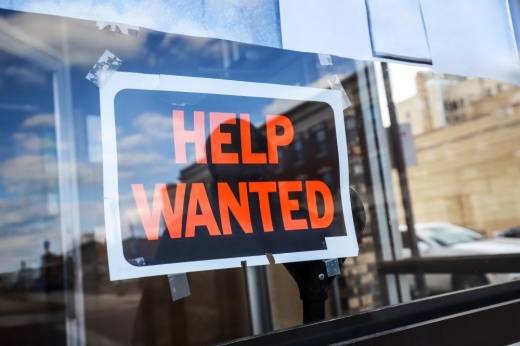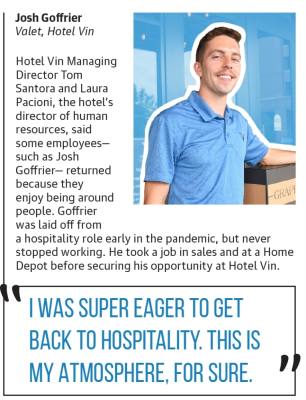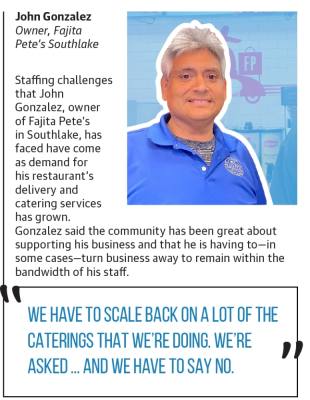Unfortunately, Gonzalez was short-staffed that day, as he said he is most days. So instead he was at his restaurant, where he often is joined by his 14-year-old son Xavier and his wife, Patricia, who also works full-time as a physician.
“[There are] days that if somebody calls in sick—guess what? We’re struggling,” Gonzalez said. “I’ve been [working] open-to-close every day.”
As “Now Hiring” signs have become commonplace around northeast Tarrant County, the effects of staffing shortages on local businesses are becoming more pronounced.
The U.S. Chamber of Commerce has brought back its Worker Availability Ratio (WAR), measuring the number of available workers for every job opening. It measures available workers by tallying “actively job seeking” unemployed persons, as well as others whom the U.S. Bureau of Labor Statistics classifies as not in the labor force but “marginally attached”—meaning they want jobs, are available to work and have looked for work in the past year. In April 2020, as closures and layoffs spiked, it reached as high as 5. One year after that, it was 1.2.
While Gonzalez may not have been able to attend the fair in Irving, other businesses from Grapevine, Colleyville and Southlake did.
Unique Landscaping from Colleyville and Highland Landscaping from Southlake were present, trying to fill nearly 30 positions between them. Amanda Bailey, a manager for the Mooyah Burgers, Fries & Shakes in Colleyville, said she has eight positions to fill. Costa Vida Fresh Mexican Grill, also in Colleyville, had a table to recruit potential employees, too. Even the public sector was represented—representatives for Grapevine-Colleyville ISD, for instance, talked with job-seekers.
Gov. Greg Abbott opted Texas out of additional federal unemployment benefits effective June 26, but it’s unclear how much that decision has affected the job market.
RaDonna Hessel, CEO of the Grapevine Chamber of Commerce, said she has heard from some members about an increase in applicants, but that, with so many openings, prospective employers are still left fighting over those candidates pursuing new jobs. “Some of the hotels have talked about where they used to maybe get one application, now they’re getting three, four or five,” Hessel said. “But it’s just like anything—they’re all competing for the same pool of people.”
Some small business owners have seen an uptick in applications but say those who are returning to look for work are doing so with new expectations. The changing dynamics of what job-seekers are expecting is something Rodney Johnson, director of the Tarrant Small Business Development Center, said he has noticed, too.
“People are seeing that there are greater opportunities out there for them to go and make money,” Johnson said. “There are a lot of dynamics. You’re chasing money, you’re chasing safety—and, in the end, you’re also chasing opportunity.”
Some larger corporations began raising wages even before the pandemic. Amazon, for instance, raised its starting wage for U.S. employees to $15 an hour in 2018. In fierce competition for unemployed individuals who are seeking jobs, larger corporations often have a leg up in what they can offer—but local companies are exploring ways to compete.
Some, while perhaps not starting at $15 an hour, nonetheless feel competitive. Colleyville-based Unique Landscaping, for instance, starts employees at $13.75 an hour and pays some staff more than $35 an hour, according to Donna Kauffman, who is co-owner along with Kurt Kauffman, her husband. Others tout workplace culture, scheduling stability they can provide and the possibility for upward mobility in a smaller, family-run business.
“It’s an employee-market right now as far as jobs are concerned, so they’re looking at ‘How am I going to be treated here?’” said Chelsea Rose, the president and CEO of the Colleyville Chamber of Commerce. “Yes, obviously the salary and hourly rate is important ... but you could be making all kinds of money and being treated poorly.”
Hotel Vin, which opened in downtown Grapevine in September, has seen its staff grow from around 40 employees to 140, with room for 35 more in a mix of roles, according to Laura Pacioni, the hotel’s director of human resources. One way Pacioni and Tom Santora, the hotel’s managing director, are seeking to fill those openings is with the hotel’s culture.
“Showing them ‘This is how we’ll invest in you when you get here,’” Pacioni said. “The comment I get ... is, ‘Oh, it just feels good here.’”
Santora, who is also the Chief Commercial Officer for Coury Hospitality, said that Hotel Vin has tried a number of programs to keep staffed, including signing bonuses for new hires. But, as he tells it, one of the more valuable resources for keeping staffed has been employees already in-house.
“Our most successful has been developing an internal referral program,” he said. “People like to work with people like themselves.”
Pacioni and Santora also said that Hotel Vin has benefited from doing a hiring push around its opening, during a time in 2020 when many other hospitality venues were shut down and employees were furloughed or laid off. Now, as those employers have reopened and looked to retain some of those employees, many who found work at Hotel Vin have decided to remain there, they explained.
A consistent thread from employers is that the power dynamic has shifted in favor of employees. Johnson, whose work at the Tarrant Small Business Development Center involves coaching and advising entrepreneurs, said one of the dynamics he is monitoring is that individuals in the workforce seem less hesitant to make a big decision—whether it is leaving a job, taking a job or passing on a job—than was the case before the pandemic.
“One of the things ... we’re having to struggle with is [employees saying]—’if I’m not happy in my job, I’m going to look for anther job,” he said. “That option is available. We’re in that season. ‘Take whatever you can get’ is not the order of the day.”
Ultimately, Johnson said, a lot of what communities are seeing is market forces at work.
“It comes down to the good ol’ analogy of supply-and-demand,” Johnson said. “Where there is a shortage of supply and an increase in demand, prices go up. I think that same analogy applies to the labor force.”








